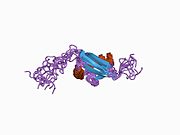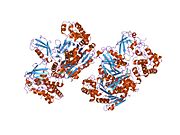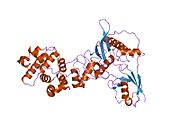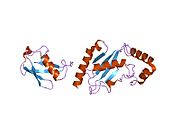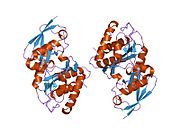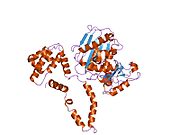SUMO1
Ensembl | |||||||||
|---|---|---|---|---|---|---|---|---|---|
| UniProt | |||||||||
| RefSeq (mRNA) | |||||||||
| RefSeq (protein) |
| ||||||||
| Location (UCSC) | Chr 2: 202.21 – 202.24 Mb | Chr 1: 59.63 – 59.71 Mb | |||||||
| PubMed search | [3] | [4] | |||||||
| View/Edit Human | View/Edit Mouse |
Small ubiquitin-related modifier 1 is a protein that in humans is encoded by the SUMO1 gene.[5][6]
Function
This gene encodes a protein that is a member of the
Most
Interactions
Small ubiquitin-related modifier 1 has been shown to
Role in the heart
Heart failure is a process by which the heart’s pumping ability is significantly weakened, so that the body is unable to get adequate circulation. A weakened heart results in symptoms of fatigue, decreased exercise tolerance and shortness of breath. Patients with heart failure have a significantly increased risk of death compared to people with normal heart function. Heart failure is a major public health concern, as its incidence is on the rise worldwide, and is a leading cause of death in developed nations [27]
SUMO 1 is a key component in cardiac function, since it helps regulate calcium homeostasis in the
As a drug target
SUMO 1 may be an important therapeutic target to help improve cardiac performance in patients with heart failure. In a mouse model, the introduction of SUMO 1 through gene therapy was associated with improved activity of SERCA2A, which resulted in improved cardiac function through an augmentation of cardiac contractility.[29] Furthermore, overexpression of SUMO 1 resulted in accelerated calcium uptake, providing further evidence regarding its importance in maintaining adequate calcium levels in heart cells.[29]
See also
References
- ^ a b c GRCh38: Ensembl release 89: ENSG00000116030 – Ensembl, May 2017
- ^ a b c GRCm38: Ensembl release 89: ENSMUSG00000026021 – Ensembl, May 2017
- ^ "Human PubMed Reference:". National Center for Biotechnology Information, U.S. National Library of Medicine.
- ^ "Mouse PubMed Reference:". National Center for Biotechnology Information, U.S. National Library of Medicine.
- PMID 8812453.
- ^ S2CID 38606511.
- ^ "Entrez Gene: SUMO1 SMT3 suppressor of mif two 3 homolog 1 (S. cerevisiae)".
- PMID 17981355.
- ^ Dixon MJ, Marazita ML, Beaty TH, Murray JC (2011). "Cleft lip and palate: understanding genetic and environmental influences". Nature Reviews Genetics (12) 167-178.
- ^ "Molecular Interaction Database". Archived from the original on 2006-05-06.
- ^ PMID 11948183.
- ^ PMID 11112409.
- ^ PMID 18583933.
- PMID 11735126.
- ^ PMID 10961991.
- PMID 14609633.
- PMID 11583632.
- PMID 9452416.
- ^ PMID 12924945.
- S2CID 7756078.
- PMID 18572193.
- PMID 11889051.
- PMID 10187798.
- ^ PMID 10862613.
- PMID 17353931.
- PMID 8921390.
- PMID 22267837.
- PMID 11444913.
- ^ PMID 21900893.
Further reading
- Cookson MR (January 2003). "Pathways to Parkinsonism". Neuron. 37 (1): 7–10. S2CID 14513509.
- Boddy MN, Howe K, Etkin LD, Solomon E, Freemont PS (September 1996). "PIC 1, a novel ubiquitin-like protein which interacts with the PML component of a multiprotein complex that is disrupted in acute promyelocytic leukaemia". Oncogene. 13 (5): 971–82. PMID 8806687.
- Bonaldo MF, Lennon G, Soares MB (September 1996). "Normalization and subtraction: two approaches to facilitate gene discovery". Genome Research. 6 (9): 791–806. PMID 8889548.
- Shen Z, Pardington-Purtymun PE, Comeaux JC, Moyzis RK, Chen DJ (October 1996). "Associations of UBE2I with RAD52, UBL1, p53, and RAD51 proteins in a yeast two-hybrid system". Genomics. 37 (2): 183–6. PMID 8921390.
- Matunis MJ, Coutavas E, Blobel G (December 1996). "A novel ubiquitin-like modification modulates the partitioning of the Ran-GTPase-activating protein RanGAP1 between the cytosol and the nuclear pore complex". The Journal of Cell Biology. 135 (6 Pt 1): 1457–70. PMID 8978815.
- Mahajan R, Delphin C, Guan T, Gerace L, Melchior F (January 1997). "A small ubiquitin-related polypeptide involved in targeting RanGAP1 to nuclear pore complex protein RanBP2". Cell. 88 (1): 97–107. S2CID 17819277.
- Lapenta V, Chiurazzi P, van der Spek P, Pizzuti A, Hanaoka F, Brahe C (March 1997). "SMT3A, a human homologue of the S. cerevisiae SMT3 gene, maps to chromosome 21qter and defines a novel gene family". Genomics. 40 (2): 362–6. PMID 9119407.
- Kamitani T, Nguyen HP, Yeh ET (May 1997). "Preferential modification of nuclear proteins by a novel ubiquitin-like molecule". The Journal of Biological Chemistry. 272 (22): 14001–4. PMID 9162015.
- Mahajan R, Gerace L, Melchior F (January 1998). "Molecular characterization of the SUMO-1 modification of RanGAP1 and its role in nuclear envelope association". The Journal of Cell Biology. 140 (2): 259–70. PMID 9442102.
- Howe K, Williamson J, Boddy N, Sheer D, Freemont P, Solomon E (January 1998). "The ubiquitin-homology gene PIC1: characterization of mouse (Pic1) and human (UBL1) genes and pseudogenes". Genomics. 47 (1): 92–100. PMID 9465300.
- Bayer P, Arndt A, Metzger S, Mahajan R, Melchior F, Jaenicke R, Becker J (July 1998). "Structure determination of the small ubiquitin-related modifier SUMO-1". Journal of Molecular Biology. 280 (2): 275–86. PMID 9654451.
- Desterro JM, Rodriguez MS, Hay RT (August 1998). "SUMO-1 modification of IkappaBalpha inhibits NF-kappaB activation". Molecular Cell. 2 (2): 233–9. PMID 9734360.
- Juo P, Kuo CJ, Yuan J, Blenis J (September 1998). "Essential requirement for caspase-8/FLICE in the initiation of the Fas-induced apoptotic cascade". Current Biology. 8 (18): 1001–8. S2CID 18129508.
- Kamitani T, Kito K, Nguyen HP, Wada H, Fukuda-Kamitani T, Yeh ET (October 1998). "Identification of three major sentrinization sites in PML". The Journal of Biological Chemistry. 273 (41): 26675–82. PMID 9756909.
- Duprez E, Saurin AJ, Desterro JM, Lallemand-Breitenbach V, Howe K, Boddy MN, Solomon E, de Thé H, Hay RT, Freemont PS (February 1999). "SUMO-1 modification of the acute promyelocytic leukaemia protein PML: implications for nuclear localisation". Journal of Cell Science. 112 ( Pt 3) (3): 381–93. PMID 9885291.
- Chen A, Mannen H, Li SS (December 1998). "Characterization of mouse ubiquitin-like SMT3A and SMT3B cDNAs and gene/pseudogenes". Biochemistry and Molecular Biology International. 46 (6): 1161–74. S2CID 45939730.
- Okuma T, Honda R, Ichikawa G, Tsumagari N, Yasuda H (January 1999). "In vitro SUMO-1 modification requires two enzymatic steps, E1 and E2". Biochemical and Biophysical Research Communications. 254 (3): 693–8. PMID 9920803.
- Liou ML, Liou HC (April 1999). "The ubiquitin-homology protein, DAP-1, associates with tumor necrosis factor receptor (p60) death domain and induces apoptosis". The Journal of Biological Chemistry. 274 (15): 10145–53. PMID 10187798.
External links
- SUMO1 human gene location in the UCSC Genome Browser.
- SUMO1 human gene details in the UCSC Genome Browser.

